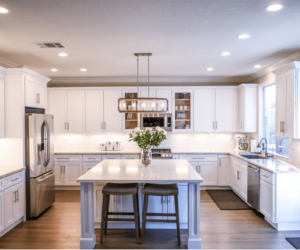Creating a well-designed and functional space requires careful consideration of furniture placement. The way we arrange furniture in a room can significantly impact both its functionality and aesthetics.
Whether you’re starting from scratch or looking to revamp your existing space, this comprehensive guide will walk you through the process of planning furniture in a room, helping you create a harmonious and inviting environment.
Check this room layout planner in Planner5D.
Understanding Your Space
Before diving into furniture arrangement, it’s essential to understand the unique characteristics of your space. Evaluate the room’s size, shape, and architectural features. Take note of doorways, windows, and other fixed elements that may influence furniture placement.
Additionally, consider the room’s primary function and intended use. This initial assessment will provide a foundation for the furniture planning process.
Defining Your Goals and Needs
To create a well-planned room, it’s crucial to identify your specific goals and needs. Think about how you will use the space and what activities will take place there.
Determine the focal point(s) within the room, such as a fireplace, a stunning view, or a prominent piece of artwork. Balancing functionality and style, prioritize your requirements, and establish a clear vision for the room’s purpose.
Furniture Selection
When planning furniture choices, it’s essential to evaluate your existing furniture. Decide what pieces you want to keep, replace, or repurpose. Consider the scale and proportion of the furniture pieces in relation to the room’s size.
Take note of their style, materials, and how they fit into your desired aesthetic. This evaluation will guide you in making informed decisions about future furniture purchases and ensure a cohesive look in the room. Also, compare furniture prices to get the best cost-effective pieces.
Creating a Floor Plan
Before moving furniture around, create an accurate floor plan. Measure the room, noting the dimensions and any architectural features.
There are various tools available, such as software or online applications, that can assist in visualizing different furniture arrangements. You can also sketch the room on paper and experiment with different layouts to find the most suitable arrangement.
Furniture Placement Strategies
Effective furniture placement follows several key principles.
- One fundamental principle is balance. Distribute furniture evenly throughout the room, considering visual weight and proportion.
Create focal points by arranging furniture around the room’s architectural features or the designated focal point you identified earlier. Additionally, ensure a logical flow of traffic, allowing for easy movement throughout the space.
- Consider arranging furniture to facilitate conversation areas, especially in living rooms or entertaining spaces. Position seating pieces facing each other, allowing for comfortable and engaging interactions.
Pay attention to ergonomics, ensuring that furniture is arranged to promote proper posture and easy access to commonly used items.
Maximizing Space and Functionality
In rooms with limited space, maximizing functionality becomes crucial. Consider multifunctional furniture that serves multiple purposes, such as storage ottomans or sleeper sofas.
Utilize vertical space by incorporating wall-mounted shelving or cabinets. Creating zones within a room can also help accommodate different activities. For example, delineate a workspace with a desk and chair or a cozy reading nook with a comfortable armchair and a floor lamp.
Styling and Accessories
Once you’ve determined the furniture placement, it’s time to add the finishing touches. Select accessories that complement the overall design. Rugs, curtains, and lighting fixtures can enhance the room’s ambiance and tie the different elements together. Add personal touches with decorative items that reflect your style and interests.
Remember to strike a balance between minimalism and clutter, ensuring that the room feels inviting without overwhelming the space.
Fine-Tuning and Adjustments
Once you’ve arranged your furniture, take a step back and assess the overall composition. Don’t be afraid to make adjustments as needed.
Experiment with different layouts and configurations to find the optimal arrangement that meets both your functional and aesthetic goals.
Seeking feedback from friends, family, or design professionals can also provide fresh perspectives and valuable insights.
Conclusion
Furniture arrangement plays a vital role in creating a harmonious and functional space. By following this comprehensive guide, you now have the tools to plan your room effectively. Understand your space, define your goals and needs, select the right furniture, and create a floor plan that aligns with your vision.
Apply key principles of furniture placement, maximize space and functionality, and add the finishing touches with complementary accessories. Remember, the process may involve fine-tuning and adjustments until you achieve the perfect arrangement.
With patience and creativity, you can master the art of furniture arrangement and transform any room into a beautiful and inviting space. Happy designing!


